>>>Natures Of Universe<<<
Home Page › Forums › API Clubhouse › Interesting Shows/Websites/Book Previews › >>>Natures Of Universe<<<
- This topic is empty.
-
AuthorPosts
-
November 3, 2005 at 1:58 pm #5198
Anonymous

Ski Enceladus
Explanation: Small, icy, inner moon of Saturn, Enceladus is only about 500 kilometers in diameter. But the distant world does reflect over 90 percent of the sunlight it receives, giving its surface about the same reflectivity as fresh snow. Seen here in a sharp view from the Cassini spacecraft’s recent flyby, Enceladus shows a variety of surface features and very few impact craters – indicating that it has been an active world even though this tiny moon should have completely cooled off long ago. In fact, the resurfaced appearance of Enceladus could be the result of liquid water geysers or water volcanos. Since Enceladus orbits within the outer E ring of Saturn, the moon’s surface may be kept snow-bright as it is continuously bombarded with icy ring particles. Eruptions on Enceladus itself would in turn supply material to the E ring. Interplanetary ski bums take note: tiny Enceladus has only about 1/100th the surface gravity of planet Earth and a surface temperature of -200 degrees C (-330 degrees F).
Credit: Cassini Imaging Team, SSI, JPL, ESA, NASA
November 3, 2005 at 1:59 pm #5199Anonymous
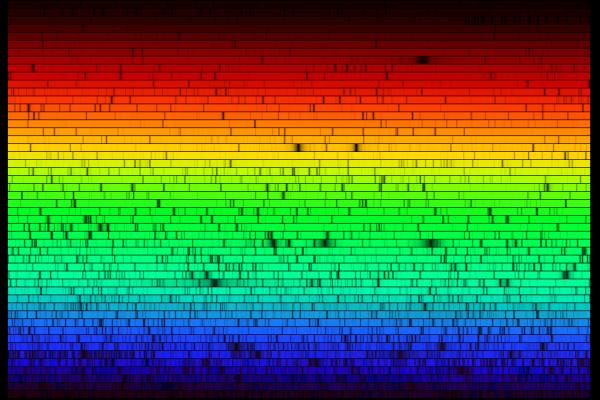
The Solar Spectrum
Explanation: It is still not known why the Sun’s light is missing some colors. Shown above are all the visible colors of the Sun, produced by passing the Sun’s light through a prism-like device. The above spectrum was created at the McMath-Pierce Solar Observatory and shows, first off, that although our yellow-appearing Sun emits light of nearly every color, it does indeed appear brightest in yellow-green light. The dark patches in the above spectrum arise from gas at or above the Sun’s surface absorbing sunlight emitted below. Since different types of gas absorb different colors of light, it is possible to determine what gasses compose the Sun. Helium, for example, was first discovered in 1870 on a solar spectrum and only later found here on Earth. Today, the majority of spectral absorption lines have been identified – but not all.
Credit & Copyright: Nigel Sharp (NSF), FTS, NSO, KPNO, AURA, NSF
November 3, 2005 at 2:01 pm #5200Anonymous
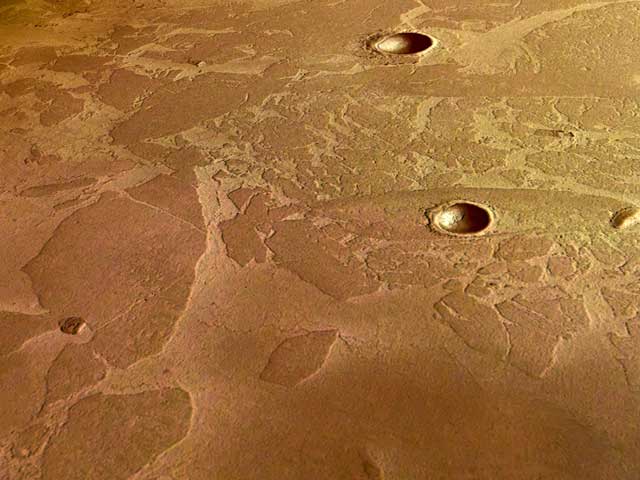
Unusual Plates on Mars
Explanation: What are those unusual plates on Mars? A leading current interpretation holds that they are blocks of ice floating on a recently frozen sea covered by dust. The unusual plates were photographed recently by the European Space Agency’s Mars Express spacecraft currently orbiting Mars. Oddly, the region lies near the Martian equator and not near either of Mars’ frozen polar caps. Without being covered by dust, any water or ice near away from the poles would quickly evaporate right into the atmosphere. Evidence that the above-imaged plates really are dust-covered water-ice includes a similarity in appearance to ice blocks off Earth’s Antarctica, nearby surface fractures from which underground water could have flowed, and the shallow depth of the craters indicating that something is filling them in. If correct, the low abundance of craters indicates that water may have flowed on Mars as recently as five million years ago.
Credit: G. Neukum (FU Berlin) et al., Mars Express, DLR, ESA
November 3, 2005 at 2:02 pm #5201Anonymous
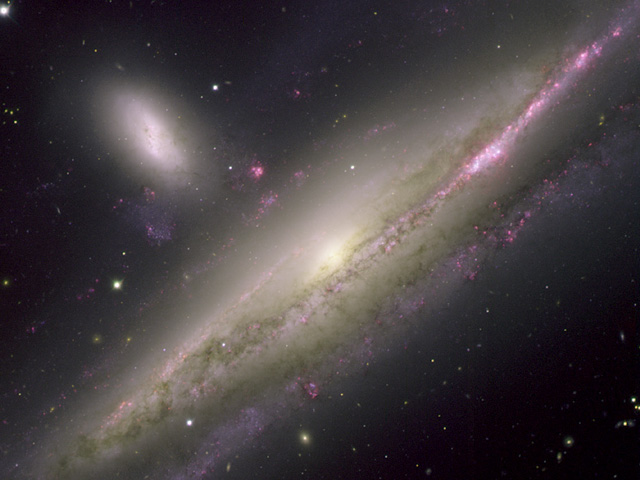
NGC 1531/2: Interacting Galaxies
Explanation: This dramatic image of an interacting pair of galaxies was made using 8-meter Gemini South telescope at Cerro Pachon, Chile. NGC 1531 is the background galaxy with a bright core just above center and NGC 1532 is the foreground spiral galaxy laced with dust lanes. The pair is about 55 million light-years away in the southern constellation Eridanus. These galaxies lie close enough together so that each feels the influence of the other’s gravity. The gravitational tug-of-war was triggered star formation in the foreground spiral as evidenced by the young, bright blue star clusters along the upper edge of the front spiral arm. Though the spiral galaxy in this pair is viewed nearly edge-on, astronomers believe the system is similar to the face-on spiral and companion known as M51, the Whirlpool Galaxy.
Credit & Copyright: T. Rector (U. Alaska Anchorage), Gemini Obs., AURA, NSF
November 4, 2005 at 3:05 am #5202Anonymous
OMG! The picture is nice o.o
blessed be
maryNovember 4, 2005 at 5:08 am #5203Anonymous
gosh! A3~ where did you get this pics and info from?
November 5, 2005 at 9:49 am #5204Anonymous
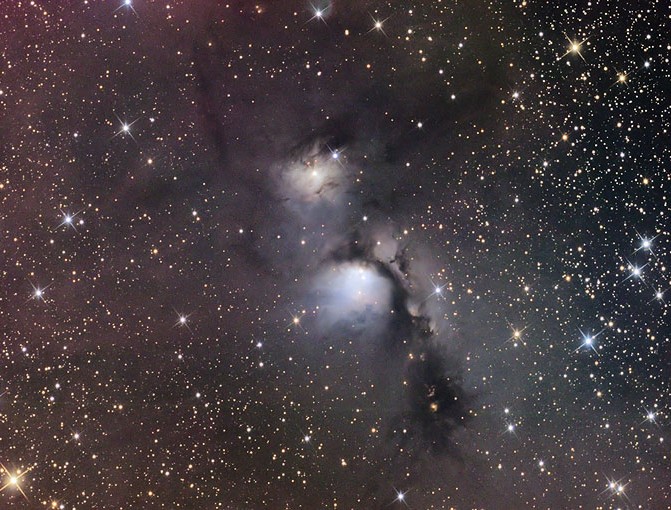
M78: Stardust and Starlight
Explanation: Interstellar dust clouds and bright nebulae abound in the fertile constellation of Orion. One of the brightest, M78, is just below center in this sharp widefield view, covering an area north of Orion’s belt. At a distance of about 1,500 light-years, the bluish nebula itself is about 5 light-years across. Its blue tint is due to dust preferentially reflecting the blue light of hot, young stars in the region. Dark dust lanes and other nebulae can easily be traced through this gorgeous skyscape that also includes the remarkable McNeil’s Nebula — a newly recognized nebula associated with the formation of a sun-like star.
Credit & Copyright: Stephan Messner
November 5, 2005 at 9:50 am #5205Anonymous
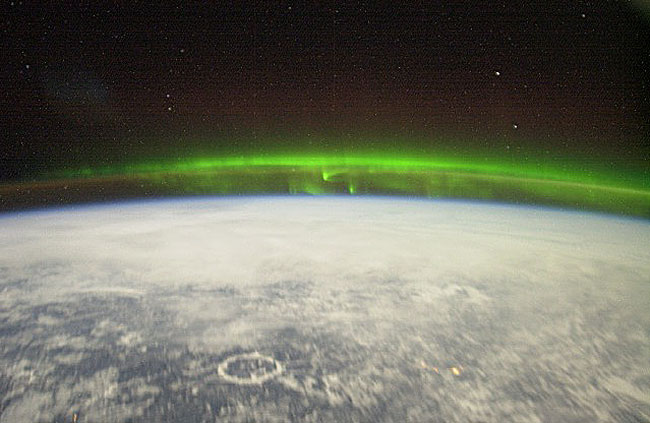
Aurora from Space
Explanation: From the ground, spectacular auroras seem to dance high above. But the International Space Station (ISS) orbits at nearly the same height as many auroras, sometimes passing over them, and sometimes right through them. Still, the auroral electron and proton streams pose no direct danger to the ISS. In 2003, ISS Science Officer Don Pettit captured the green aurora, pictured above in a digitally sharpened image. From orbit, Pettit reported that changing auroras appeared to crawl around like giant green amoebas. Over 300 kilometers below, the Manicouagan Impact Crater can be seen in northern Canada, planet Earth.
Credit: Don Pettit, ISS Expedition 6, NASA
November 5, 2005 at 9:52 am #5206Anonymous
@Amulet wrote:
gosh! A3~ where did you get this pics and info from?
http://antwrp.gsfc.nasa.gov/apod/astropix.html
jus joking hor 😉
November 17, 2005 at 3:32 pm #5207Anonymous
The last few pictures are too big. It is jamming this section.
I may have to remove them,… or you do it yourself, replace with a smaller picture
November 27, 2005 at 11:16 am #5208Anonymous
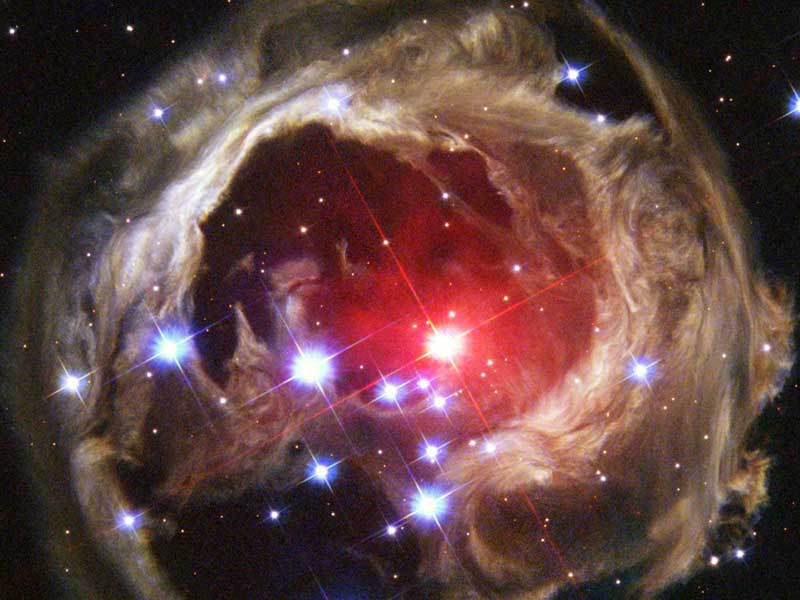
Light Echoes from V838 MonExplanation: What caused this outburst of V838 Mon? For reasons unknown, star V838 Mon’s outer surface suddenly greatly expanded with the result that it became the brightest star in the entire Milky Way Galaxy in January 2002. Then, just as suddenly, it faded. A stellar flash like this has never been seen before — supernovas and novas expel matter out into space. Although the V838 Mon flash appears to expel material into space, what is seen in the above image from the Hubble Space Telescope is actually an outwardly moving light echo of the bright flash. In a light echo, light from the flash is reflected by successively more distant rings in the complex array of ambient interstellar dust that already surrounded the star. V838 Mon lies about 20,000 light years away toward the constellation of the unicorn (Monoceros), while the light echo above spans about six light years in diameter.
Credit: NASA and the Hubble Heritage Team (AURA/STScI)
[/b] -
AuthorPosts
-
AuthorPosts
-
Anonymous- Offline

Ski Enceladus
Explanation: Small, icy, inner moon of Saturn, Enceladus is only about 500 kilometers in diameter. But the distant world does reflect over 90 percent of the sunlight it receives, giving its surface about the same reflectivity as fresh snow. Seen here in a sharp view from the Cassini spacecraft’s recent flyby, Enceladus shows a variety of surface features and very few impact craters – indicating that it has been an active world even though this tiny moon should have completely cooled off long ago. In fact, the resurfaced appearance of Enceladus could be the result of liquid water geysers or water volcanos. Since Enceladus orbits within the outer E ring of Saturn, the moon’s surface may be kept snow-bright as it is continuously bombarded with icy ring particles. Eruptions on Enceladus itself would in turn supply material to the E ring. Interplanetary ski bums take note: tiny Enceladus has only about 1/100th the surface gravity of planet Earth and a surface temperature of -200 degrees C (-330 degrees F).
Credit: Cassini Imaging Team, SSI, JPL, ESA, NASA
Anonymous- Offline

The Solar Spectrum
Explanation: It is still not known why the Sun’s light is missing some colors. Shown above are all the visible colors of the Sun, produced by passing the Sun’s light through a prism-like device. The above spectrum was created at the McMath-Pierce Solar Observatory and shows, first off, that although our yellow-appearing Sun emits light of nearly every color, it does indeed appear brightest in yellow-green light. The dark patches in the above spectrum arise from gas at or above the Sun’s surface absorbing sunlight emitted below. Since different types of gas absorb different colors of light, it is possible to determine what gasses compose the Sun. Helium, for example, was first discovered in 1870 on a solar spectrum and only later found here on Earth. Today, the majority of spectral absorption lines have been identified – but not all.
Credit & Copyright: Nigel Sharp (NSF), FTS, NSO, KPNO, AURA, NSF
Anonymous- Offline

Unusual Plates on Mars
Explanation: What are those unusual plates on Mars? A leading current interpretation holds that they are blocks of ice floating on a recently frozen sea covered by dust. The unusual plates were photographed recently by the European Space Agency’s Mars Express spacecraft currently orbiting Mars. Oddly, the region lies near the Martian equator and not near either of Mars’ frozen polar caps. Without being covered by dust, any water or ice near away from the poles would quickly evaporate right into the atmosphere. Evidence that the above-imaged plates really are dust-covered water-ice includes a similarity in appearance to ice blocks off Earth’s Antarctica, nearby surface fractures from which underground water could have flowed, and the shallow depth of the craters indicating that something is filling them in. If correct, the low abundance of craters indicates that water may have flowed on Mars as recently as five million years ago.
Credit: G. Neukum (FU Berlin) et al., Mars Express, DLR, ESA
Anonymous- Offline

NGC 1531/2: Interacting Galaxies
Explanation: This dramatic image of an interacting pair of galaxies was made using 8-meter Gemini South telescope at Cerro Pachon, Chile. NGC 1531 is the background galaxy with a bright core just above center and NGC 1532 is the foreground spiral galaxy laced with dust lanes. The pair is about 55 million light-years away in the southern constellation Eridanus. These galaxies lie close enough together so that each feels the influence of the other’s gravity. The gravitational tug-of-war was triggered star formation in the foreground spiral as evidenced by the young, bright blue star clusters along the upper edge of the front spiral arm. Though the spiral galaxy in this pair is viewed nearly edge-on, astronomers believe the system is similar to the face-on spiral and companion known as M51, the Whirlpool Galaxy.
Credit & Copyright: T. Rector (U. Alaska Anchorage), Gemini Obs., AURA, NSF
Anonymous- Offline
OMG! The picture is nice o.o
blessed be
mary
Anonymous- Offline
gosh! A3~ where did you get this pics and info from?
Anonymous- Offline

M78: Stardust and Starlight
Explanation: Interstellar dust clouds and bright nebulae abound in the fertile constellation of Orion. One of the brightest, M78, is just below center in this sharp widefield view, covering an area north of Orion’s belt. At a distance of about 1,500 light-years, the bluish nebula itself is about 5 light-years across. Its blue tint is due to dust preferentially reflecting the blue light of hot, young stars in the region. Dark dust lanes and other nebulae can easily be traced through this gorgeous skyscape that also includes the remarkable McNeil’s Nebula — a newly recognized nebula associated with the formation of a sun-like star.
Credit & Copyright: Stephan Messner
Anonymous- Offline

Aurora from Space
Explanation: From the ground, spectacular auroras seem to dance high above. But the International Space Station (ISS) orbits at nearly the same height as many auroras, sometimes passing over them, and sometimes right through them. Still, the auroral electron and proton streams pose no direct danger to the ISS. In 2003, ISS Science Officer Don Pettit captured the green aurora, pictured above in a digitally sharpened image. From orbit, Pettit reported that changing auroras appeared to crawl around like giant green amoebas. Over 300 kilometers below, the Manicouagan Impact Crater can be seen in northern Canada, planet Earth.
Credit: Don Pettit, ISS Expedition 6, NASA
Anonymous- Offline
@Amulet wrote:
gosh! A3~ where did you get this pics and info from?
http://antwrp.gsfc.nasa.gov/apod/astropix.html
jus joking hor 😉
Anonymous- Offline
The last few pictures are too big. It is jamming this section.
I may have to remove them,… or you do it yourself, replace with a smaller picture
Anonymous- Offline

Light Echoes from V838 MonExplanation: What caused this outburst of V838 Mon? For reasons unknown, star V838 Mon’s outer surface suddenly greatly expanded with the result that it became the brightest star in the entire Milky Way Galaxy in January 2002. Then, just as suddenly, it faded. A stellar flash like this has never been seen before — supernovas and novas expel matter out into space. Although the V838 Mon flash appears to expel material into space, what is seen in the above image from the Hubble Space Telescope is actually an outwardly moving light echo of the bright flash. In a light echo, light from the flash is reflected by successively more distant rings in the complex array of ambient interstellar dust that already surrounded the star. V838 Mon lies about 20,000 light years away toward the constellation of the unicorn (Monoceros), while the light echo above spans about six light years in diameter.
Credit: NASA and the Hubble Heritage Team (AURA/STScI)
[/b] -
AuthorPosts
- You must be logged in to reply to this topic.
Bukit Brown Announcement
Dear Reader, For all Bukit Brown related matters and tours, please visit Bukit Brown's main website. API is part of the growing community fighting to save the resting place of our forefathers, from being destroyed by the present day government, through the construction of a 8 lane highway to replace the current Lornie Road. What do we know of the early Singaporeans who came, once loved, lived, died in, & died for this Country we called Singapore? Learn about them in Bukit Brown, and the Pride of being a Singaporean. Join our free Bukit Brown Tours and be a BROWNIE on our YouTube video. Join the Bukit Brown's community Facebook page.
Copyright © 2024 · All Rights Reserved · Asia Paranormal Investigators
Purpose Theme by Organic Themes · WordPress Hosting · RSS Feed · Log in